Determining an Appropriate Parameter of Analytical Wake Models for Energy Capture and Layout Optimization on Wind Farms
Abstract
:1. Introduction
2. Wake Models
2.1. Jensen Wake Model
2.2. Frandsen Wake Model
2.3. Larsen Wake Model
2.4. Jensen–Gaussian Wake Model
2.5. Partial and Multiple Wakes
2.6. Wake Model Parameters
3. Wake Model Comparison for an Onshore Wind Farm
3.1. Wind Farm Layout
3.2. Wind Speed Deficit Comparison
3.3. Power Deficit Comparison
3.4. Energy Production Comparison
4. Conclusions
- (1)
- Among the analytical wake models, the Jensen–Gaussian and the Jensen model showed generally satisfactory results for the power deficit due to wakes within the scope of this study. The Frandsen and Larsen models underestimated the wake loss, but the wake diameter of the Larsen model was most similar to the actual range.
- (2)
- In many studies, the WDC of the conventional Jensen model was set in relation to the roughness length of the site or with the recommended values (offshore = 0.04, onshore = 0.075). This makes it difficult to ensure accuracy among sites with different environments. Peña et al.’s method of introducing a turbulence intensity that can be measured at the site appears to be appropriate within the scope of this study and can relieve the burden of determining parameters for analysts.
- (3)
- When the same WDC was applied in all directions, the result matched the measured values in some cases and did not in other cases. However, when the WDC was set according to the turbulence intensity measured at the site by direction, all calculation results matched well with the measured values. Therefore, the WDC should be set according to the direction when applied to analytical wake models.
- (4)
- The comparison of the calculated energy production of the wind farm showed that the maximum energy loss difference among the wake models was approximately 3%. The Jensen–Gaussian model predicted the largest wake loss, and the Frandsen and Larsen models predicted the smallest wake losses. However, all wake models followed the similar wake loss tendency according to the location of the wind turbine.
Funding
Conflicts of Interest
References
- Serrano González, J.; Burgos Payán, M.; Santos, J.M.R.; González-Longatt, F. A review and recent developments in the optimal wind-turbine micro-siting problem. Renew. Sustain. Energy Rev. 2014, 30, 133–144. [Google Scholar] [CrossRef]
- Shakoor, R.; Hassan, M.Y.; Raheem, A.; Wu, Y.K. Wake effect modeling: A review of wind farm layout optimization using Jensen’s model. Renew. Sustain. Energy Rev. 2016, 58, 1048–1059. [Google Scholar] [CrossRef]
- Sanderse, B. Aerodynamics of Wind Turbine Wakes Literature Review; ECN: Petten, The Netherlands, 2009. [Google Scholar]
- Lissaman, P.B.S. Energy Effectiveness of Arbitrary Arrays of Wind Turbines. J. Energy 1979, 3, 323–328. [Google Scholar] [CrossRef]
- Jensen, N.O. A Note on Wind Generator Interaction; Risø National Laboratory: Roskilde, Denmark, 1983. [Google Scholar]
- Katic, I.; Højstrup, J.; Jensen, N.O. A Simple Model for Cluster Efficiency. In Proceedings of the European Wind Energy Association Conference and Exhibition (EWEA), Rome, Italy, 7–9 October 1986; pp. 407–410. [Google Scholar]
- Tian, L.; Zhu, W.; Shen, W.; Zhao, N.; Shen, Z. Development and validation of a new two-dimensional wake model for wind turbine wakes. J. Wind Eng. Ind. Aerodyn. 2015, 137, 90–99. [Google Scholar] [CrossRef] [Green Version]
- Gao, X.; Yang, H.; Lu, L. Optimization of wind turbine layout position in a wind farm using a newly-developed two-dimensional wake model. Appl. Energy 2016, 174, 192–200. [Google Scholar] [CrossRef]
- Sun, H.; Yang, H. Study on an innovative three-dimensional wind turbine wake model. Appl. Energy 2018, 226, 483–493. [Google Scholar] [CrossRef]
- Xie, S.; Archer, C. Self-similarity and turbulence characteristics of wind turbine wakes via large-eddy simulation. Wind Energy 2015, 18, 1815–1838. [Google Scholar] [CrossRef]
- Bastankhah, M.; Porté-agel, F. A new analytical model for wind-turbine wakes. Renew. Energy 2014, 70, 116–123. [Google Scholar] [CrossRef]
- Frandsen, S.; Barthelmie, R.; Pryor, S.; Rathmann, O.; Larsen, S. Analytical Modelling of Wind Speed Deficit in Large Offshore Wind Farms. Wind Energy 2006, 9, 39–53. [Google Scholar] [CrossRef]
- Larsen, G.C. A Simple Wake Calculation Procedure; Risø National Laboratory: Roskilde, Denmark, 1988. [Google Scholar]
- Larsen, G.C. A Simple Stationary Semi-Analytical Wake Model; Risø National Laboratory: Roskilde, Denmark, 2009. [Google Scholar]
- Ainslie, J.F. Calculating the flowfield in the wake of wind turbines. J. Wind Eng. Ind. Aerodyn. 1988, 27, 213–224. [Google Scholar] [CrossRef]
- Schlez, W.; Neubert, A.; Smith, G. New developments in precision wind farm modelling. In Deutsche Windenergie Konferenz; Bremen, Germany, 2006; pp. 1–4. Available online: https://www.researchgate.net/profile/Anja_Neubert/publication/228901028_New_developments_in_precision_wind_farm_modelling/links/0c9605390a61a436b9000000/New-developments-in-precision-wind-farm-modelling.pdf (accessed on 3 February 2020).
- Ott, S.; Berg, J.; Nielsen, M. Linearised CFD Models for Wakes; Risø National Laboratory: Roskilde, Denmark, 2011. [Google Scholar]
- Larsen, G.C.; Madsen Aagaard, H.; Bingöl, F.; Mann, J.; Ott, S.; Sørensen, J.N.; Okulov, V.; Troldborg, N.; Nielsen, N.M.; Thomsen, K.; et al. Dynamic Wake Meandering Modeling; Risø National Laboratory Technology University: Roskilde, Denmark, 2007. [Google Scholar]
- Larsen, G.C.; Madsen, H.A.; Torben, J.; Troldborg, N.; Troldborg, N. Wake Modeling and Simulation; Risø National Laboratory: Roskilde, Denmark, 2008. [Google Scholar]
- Calaf, M.; Meneveau, C.; Meyers, J. Large eddy simulation study of fully developed wind-turbine array boundary layers. Phys. Fluids 2010, 22, 015110. [Google Scholar] [CrossRef] [Green Version]
- Wu, Y.T.; Porté-Agel, F. Large-Eddy Simulation of Wind-Turbine Wakes: Evaluation of Turbine Parametrisations. Bound. Layer Meteorol. 2011, 138, 345–366. [Google Scholar] [CrossRef]
- Cortina, G.; Sharma, V.; Calaf, M. Wind farm density and harvested power in very large wind farms: A low-order model. Phys. Rev. Fluids 2017, 2, 074601. [Google Scholar] [CrossRef]
- Beaucage, P.; Brower, M.; Robinson, N.; Alonge, C. Overview of six commercial and research wake models for large offshore wind farms. In Proceedings of the European Wind Energy Conference Exhibition (EWEC), Copenhagen, Denmark, 16–19 April 2012; Volume 1, pp. 213–222. [Google Scholar]
- Barthelmie, R.J.; Folkerts, L.; Larsen, G.C.; Rados, K.; Pryor, S.C.; Frandsen, S.T.; Lange, B.; Schepers, G. Comparison of wake model simulations with offshore wind turbine wake profiles measured by sodar. J. Atmos. Ocean Technol. 2006, 23, 888–901. [Google Scholar] [CrossRef]
- Barthelmie, R.J.; Jensen, L.E. Evaluation of wind farm efficiency and wind turbine wakes at the Nysted offshore wind farm. Wind Energy 2010, 13, 573–586. [Google Scholar] [CrossRef]
- Barthelmie, R.J.; Pryor, S.C.; Frandsen, S.T.; Hansen, K.S.; Schepers, J.G.; Rados, K.; Schlez, W.; Neubert, A.; Jensen, L.E.; Neckelmann, S. Quantifying the impact of wind turbine wakes on power output at offshore wind farms. J. Atmos. Ocean Technol. 2010, 27, 1302–1317. [Google Scholar] [CrossRef]
- Barthelmie, R.J.; Frandsen, S.T.; Rathmann, O.; Hansen, K.S.; Politis, E.; Prospathopoulos, P.-J.; Schepers, J.G.; Rados, K.; Cabezón, D.; Schlez, W.; et al. Flow and Wakes in Large Wind Farms: Final Report for UpWind; Risø National Laboratory: Roskilde, Denmark, 2011; ISBN 9788755038783. [Google Scholar]
- Tong, W.; Chowdhury, S.; Zhang, J.; Messac, A. Impact of different wake models on the estimation of wind farm power generation. In Proceedings of the 12th AIAA Aviation Technology, Integration, and Operations (ATIO) Conference and 14th AIAA/ISSMO Multidisciplinary Analysis and Optimization Conference, Indianapolis, Indiana, 17–19 September 2012. [Google Scholar]
- Brusca, S.; Lanzafame, R.; Famoso, F.; Galvagno, A.; Messina, M.; Mauro, S.; Prestipino, M. On the Wind Turbine Wake Mathematical Modelling. Energy Procedia 2018, 148, 202–209. [Google Scholar] [CrossRef]
- Göçmen, T.; Van Der Laan, P.; Réthoré, P.E.; Diaz, A.P.; Larsen, G.C.; Ott, S. Wind turbine wake models developed at the technical university of Denmark: A review. Renew. Sustain. Energy Rev. 2016, 60, 752–769. [Google Scholar]
- Archer, C.L.; Vasel-Be-Hagh, A.; Yan, C.; Wu, S.; Pan, Y.; Brodie, J.F.; Maguire, A.E. Review and evaluation of wake loss models for wind energy applications. Appl. Energy 2018, 226, 1187–1207. [Google Scholar] [CrossRef]
- Vermeer, L.J.; Sørensen, J.N.; Crespo, A. Wind turbine wake aerodynamics. Prog. Aerosp. Sci. 2003, 39, 467–510. [Google Scholar] [CrossRef]
- Schepers, J.G. ENDOW: Validation and Improvement of ECN’s Wake Model; ECN: Petten, The Netherlands, 2003; p. 113. [Google Scholar]
- Schlichting, H. Boundary-Layer Theory, 6th ed.; McGrow-Hill: New York, NY, USA, 1968. [Google Scholar]
- Yang, K.; Kwak, G.; Cho, K.; Huh, J. Wind farm layout optimization for wake effect uniformity. Energy 2019, 183, 983–995. [Google Scholar] [CrossRef]
- Park, J.; Law, K.H. Layout optimization for maximizing wind farm power production using sequential convex programming. Appl. Energy 2015, 151, 320–334. [Google Scholar] [CrossRef]
- Porté-Agel, F.; Bastankhah, M.; Shamsoddin, S. Wind-Turbine and Wind-Farm Flows: A Review. Bound. Layer Meteorol. 2020, 174, 1–59. [Google Scholar] [CrossRef] [PubMed] [Green Version]
- Crespo, A.; Hernández, J. Turbulence characteristics in wind-turbine wakes. J. Wind Eng. Ind. Aerodyn. 1996, 61, 71–85. [Google Scholar] [CrossRef]
- Penã, A.; Réthoré, P.E.; Van Der Laan, M.P. On the application of the Jensen wake model using a turbulence-dependent wake decay coefficient: The Sexbierum case. Wind Energy 2016, 19, 763–776. [Google Scholar] [CrossRef] [Green Version]
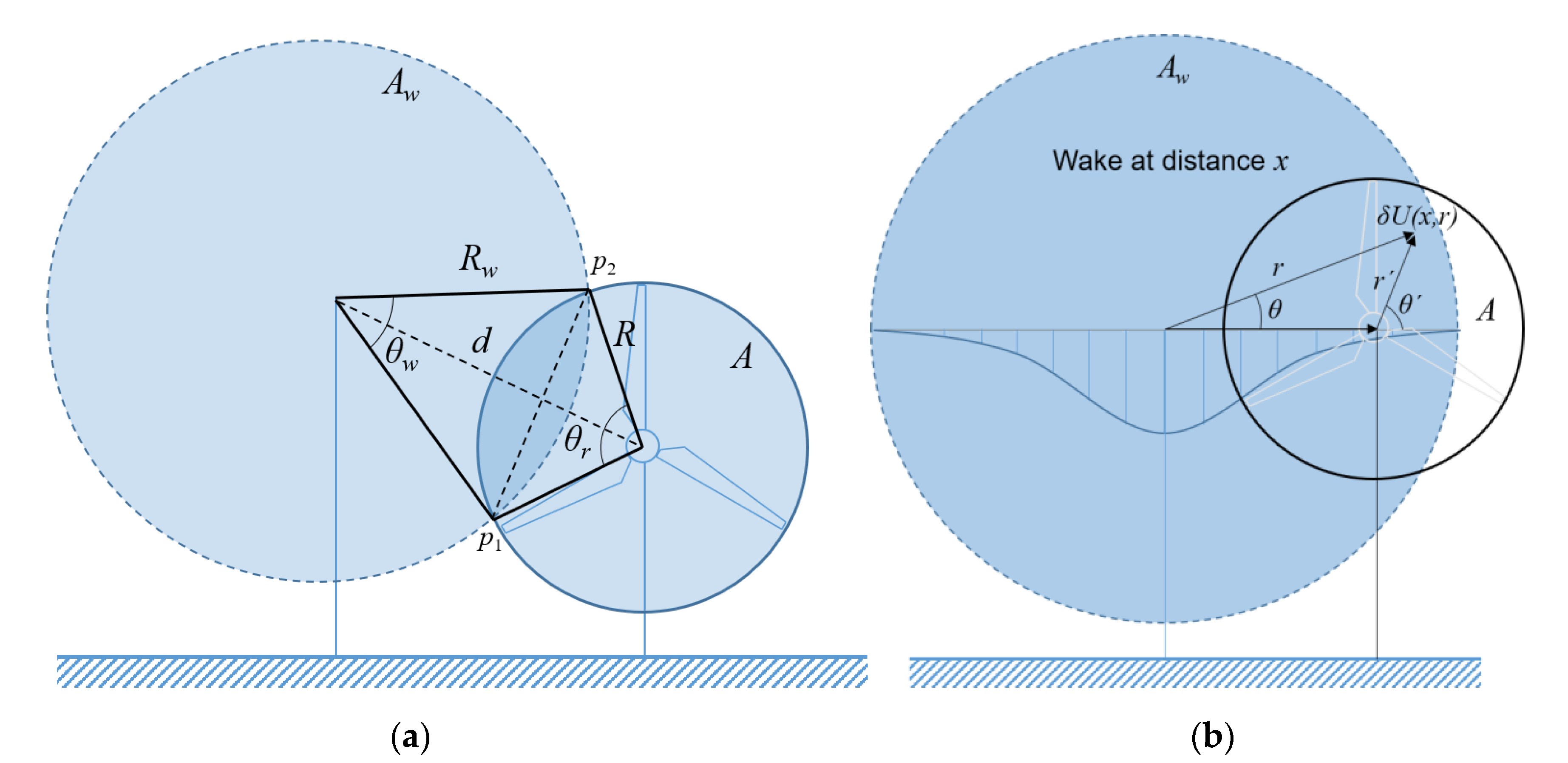


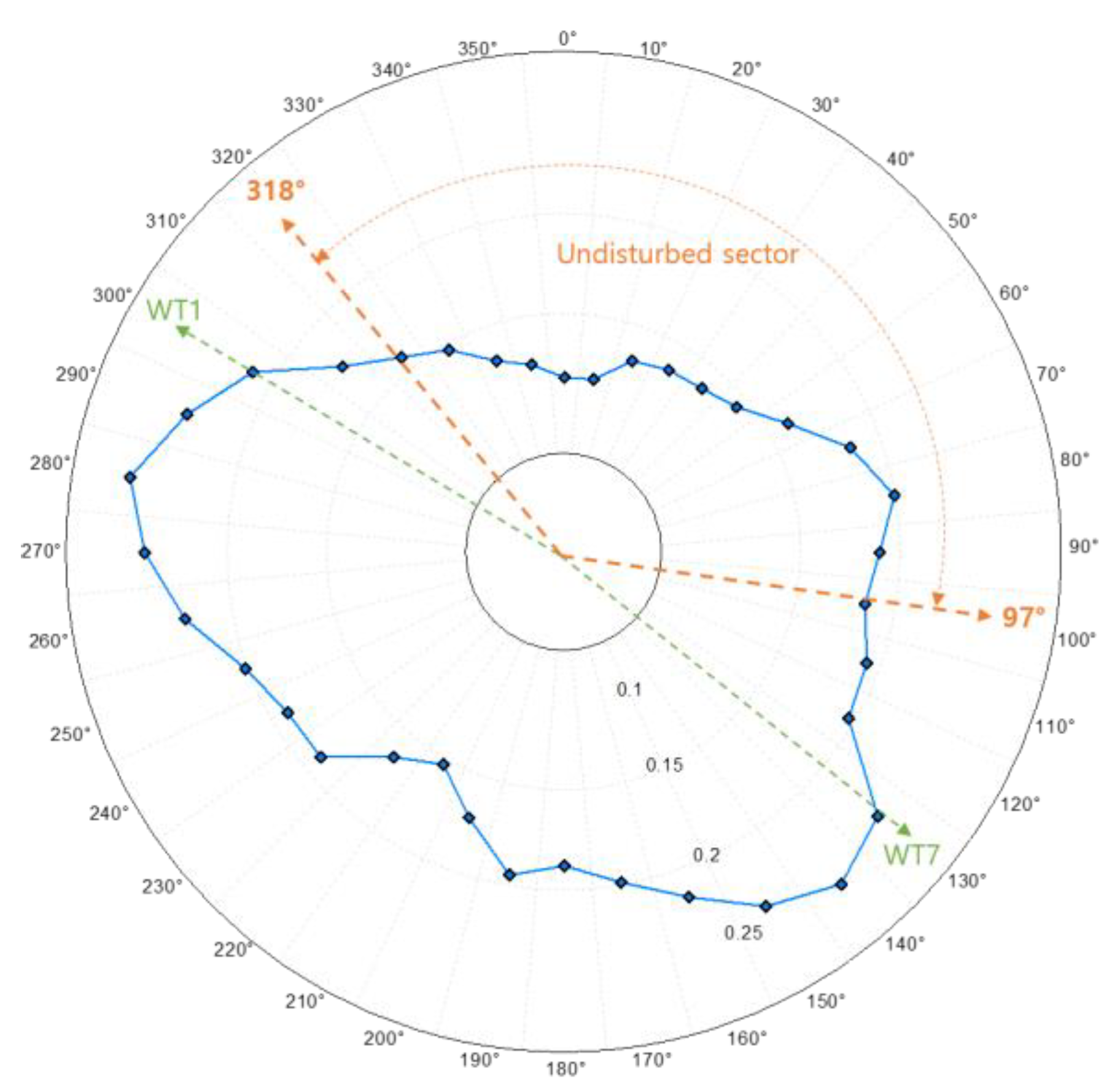

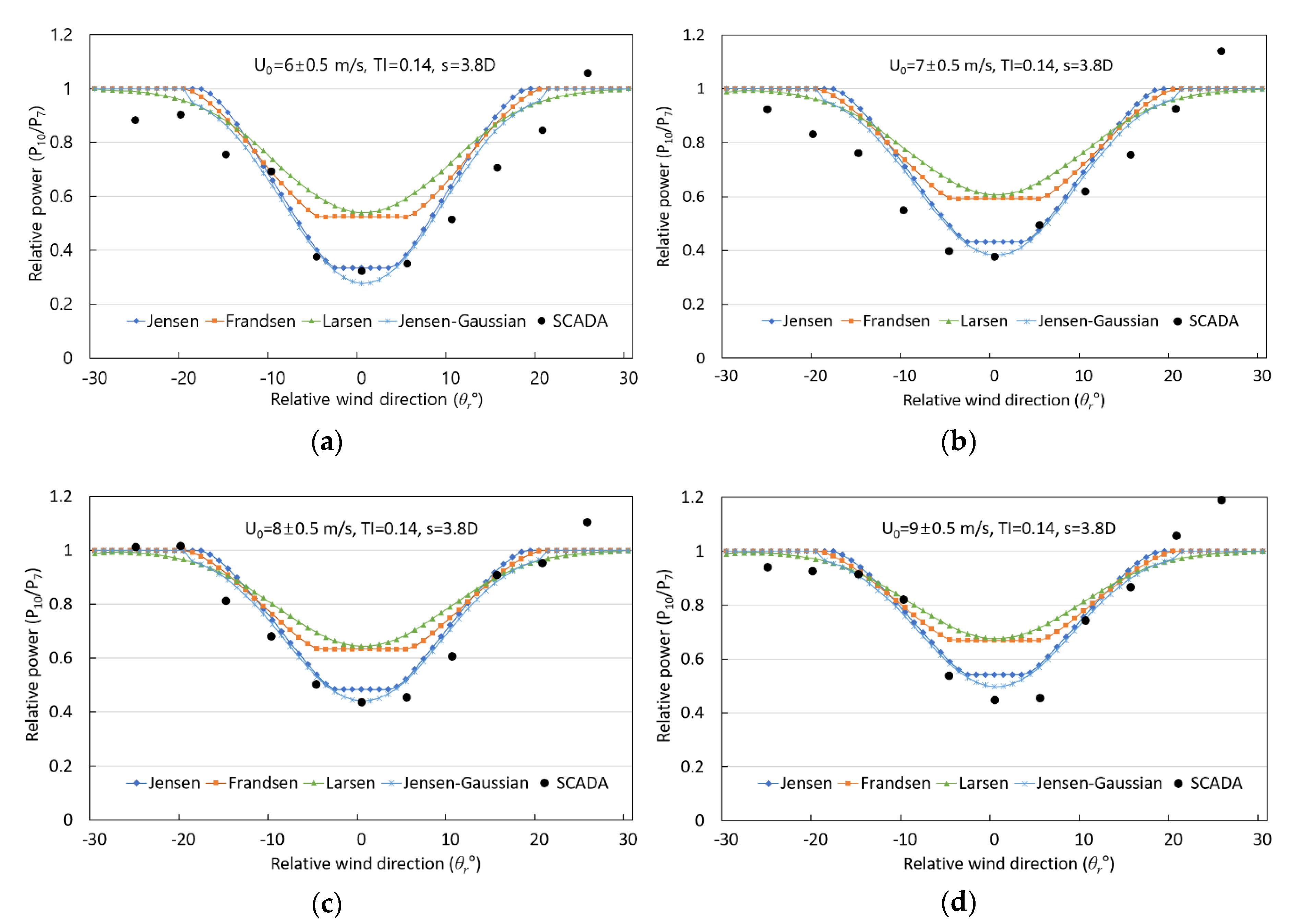
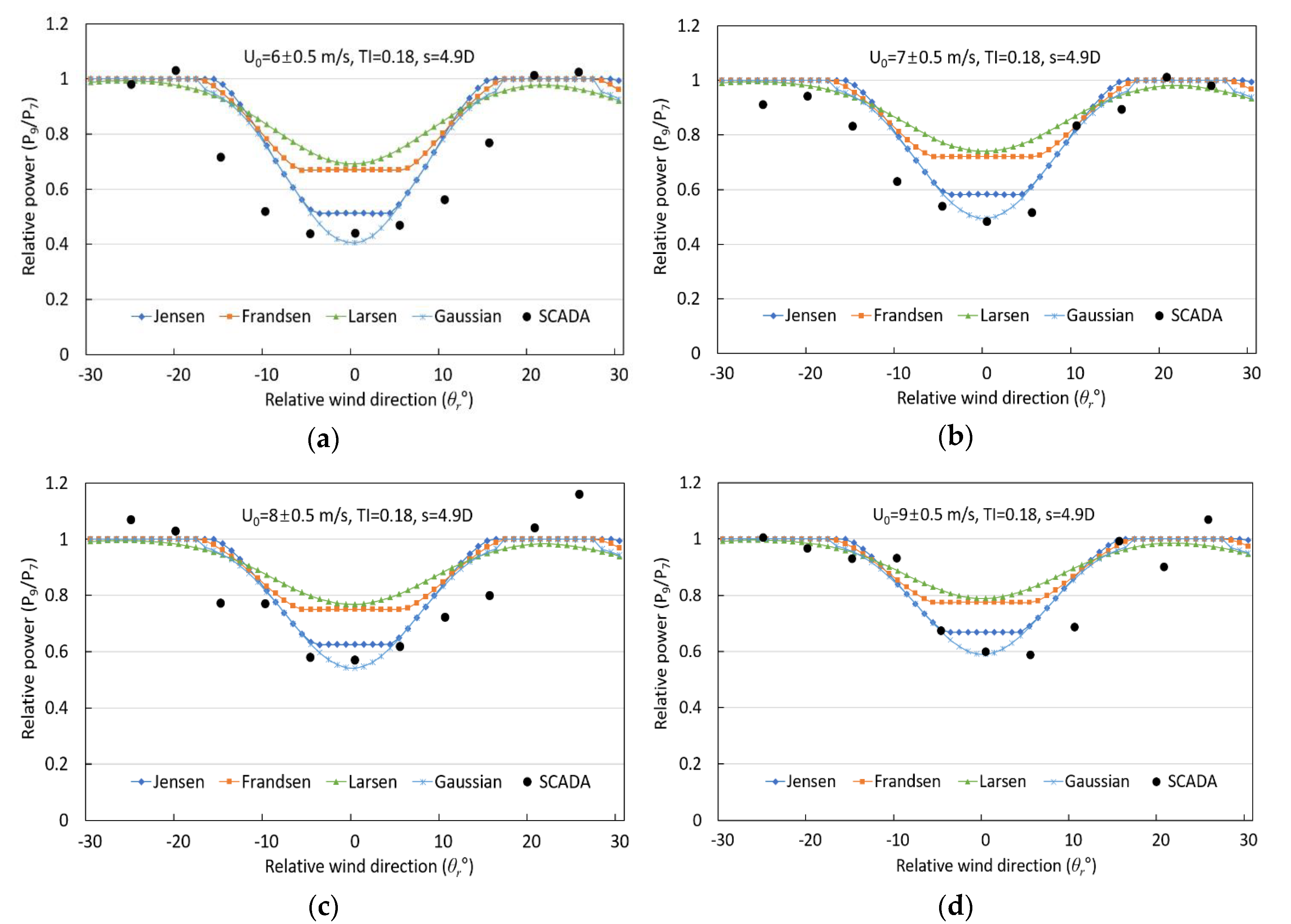

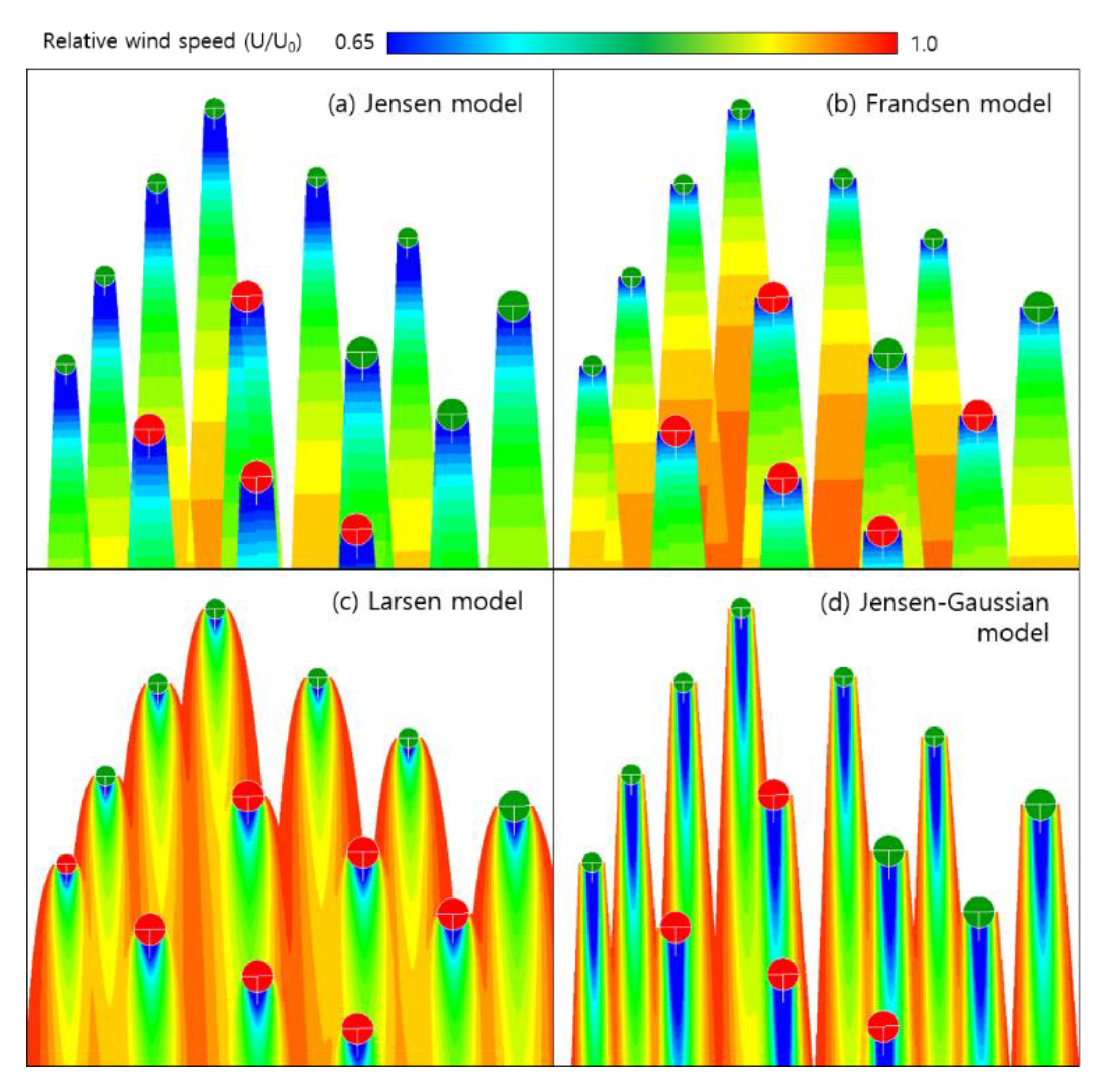
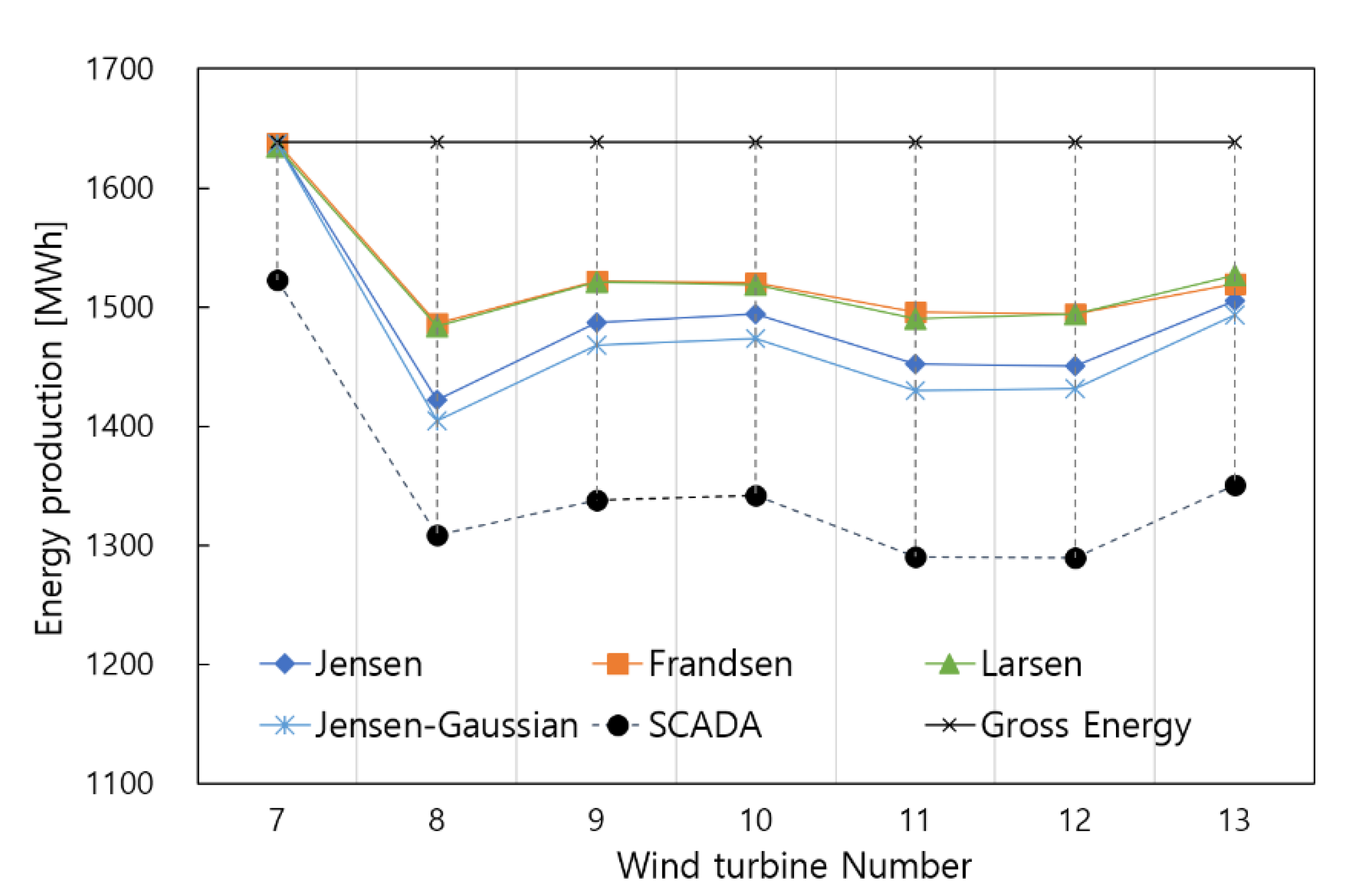
| Specification | Value |
|---|---|
| Rated power [kW] | 1500 |
| Hub height [m] | 70 |
| Rotor diameter [m] | 77 |
| Cut-in wind speed [m/s] | 3.5 |
| Rated wind speed [m/s] | 13 |
| Cut-out wind speed [m/s] | 25 |
| θr° | −25 | −20 | −15 | −10 | −5 | 0 | 5 | 10 | 15 | 20 | 25 |
|---|---|---|---|---|---|---|---|---|---|---|---|
| 6 m/s | 11.7 | 9.6 | 24.4 | 30.6 | 62.3 | 67.6 | 64.8 | 48.5 | 29.2 | 15.4 | −5.8 |
| 7 m/s | 7.5 | 16.8 | 23.9 | 45.0 | 60.1 | 62.2 | 50.6 | 38.1 | 24.5 | 7.4 | −14.1 |
| 8 m/s | −1.4 | −1.7 | 18.6 | 31.7 | 49.6 | 56.2 | 54.4 | 39.2 | 9.1 | 4.6 | −10.6 |
| 9 m/s | 5.8 | 7.4 | 8.4 | 17.9 | 46.1 | 55.2 | 54.5 | 25.6 | 13.2 | −5.8 | −19.2 |
| θr° | −25 | −20 | −15 | −10 | −5 | 0 | 5 | 10 | 15 | 20 | 25 |
|---|---|---|---|---|---|---|---|---|---|---|---|
| 6 m/s | 2.0 | −3.1 | 28.4 | 47.9 | 56.1 | 56.0 | 53.1 | 43.8 | 23.1 | −1.3 | −2.5 |
| 7 m/s | 8.9 | 5.7 | 16.8 | 37.0 | 46.0 | 51.6 | 48.3 | 16.5 | 10.5 | −1.2 | 1.8 |
| 8 m/s | −7.0 | −3.0 | 22.7 | 22.9 | 41.9 | 43.0 | 38.1 | 27.8 | 19.9 | −4.0 | −16.1 |
| 9 m/s | −0.7 | 3.2 | 6.9 | 6.8 | 32.5 | 40.1 | 41.2 | 31.2 | 0.6 | 9.9 | −7.0 |
© 2020 by the author. Licensee MDPI, Basel, Switzerland. This article is an open access article distributed under the terms and conditions of the Creative Commons Attribution (CC BY) license (http://creativecommons.org/licenses/by/4.0/).
Share and Cite
Yang, K. Determining an Appropriate Parameter of Analytical Wake Models for Energy Capture and Layout Optimization on Wind Farms. Energies 2020, 13, 739. https://doi.org/10.3390/en13030739
Yang K. Determining an Appropriate Parameter of Analytical Wake Models for Energy Capture and Layout Optimization on Wind Farms. Energies. 2020; 13(3):739. https://doi.org/10.3390/en13030739
Chicago/Turabian StyleYang, Kyoungboo. 2020. "Determining an Appropriate Parameter of Analytical Wake Models for Energy Capture and Layout Optimization on Wind Farms" Energies 13, no. 3: 739. https://doi.org/10.3390/en13030739




